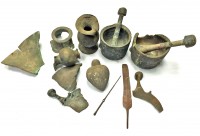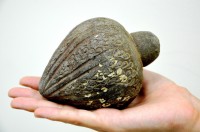 A group of artifacts recently turned in to the Israel Antiquities Authority (IAA) include a striking embossed hand grenade from the Crusader era. The objects were collected by the late Marcel Mazliah who worked at the Orot Rabin power station in Hadera on the northwest Mediterranean coast of Israel since it was built in 1973. Over the years, he found a broad assortment of archaeological treasures in the sea, probably lost in shipwrecks or simply overboard.
A group of artifacts recently turned in to the Israel Antiquities Authority (IAA) include a striking embossed hand grenade from the Crusader era. The objects were collected by the late Marcel Mazliah who worked at the Orot Rabin power station in Hadera on the northwest Mediterranean coast of Israel since it was built in 1973. Over the years, he found a broad assortment of archaeological treasures in the sea, probably lost in shipwrecks or simply overboard.
The Mazliah family contacted the IAA after Marcel died and they inherited his less-than-legal collection. An expert went to their home to examine the artifacts and was surprised to find such significant pieces.
According to Mrs. Ayala Lester, a curator with the Israel Antiquities Authority, “The finds include a toggle pin and the head of a knife from the Middle Bronze Age (from more than 3,500 years ago). The other items, among them, two mortars and two pestles, fragments of candlesticks, etc. date to the Fatimid period (eleventh century CE). The items were apparently manufactured in Syria and were brought to Israel. The finds are evidence of the metal trade that was conducted during this period”.
 The hand grenade is a handsome example of a weapon in common use by Islamic forces during the Crusader (1099-1187), Ayyubid (1187-1250) and Mamluk (1260-1516) periods. It is made of unglazed ceramic and embossed with grooves and tear drop-shaped designs. It has a domed top over a spherical body that tapers to a point. They were filled with incendiary material – petroleum, naphtha, Greek fire — and thrown or catapulted into the enemy camp where they exploded fire that water could not put out on their targets. There’s a small hole in the top into which flammable liquid could be poured and a wick added once the grenade was loaded.
The hand grenade is a handsome example of a weapon in common use by Islamic forces during the Crusader (1099-1187), Ayyubid (1187-1250) and Mamluk (1260-1516) periods. It is made of unglazed ceramic and embossed with grooves and tear drop-shaped designs. It has a domed top over a spherical body that tapers to a point. They were filled with incendiary material – petroleum, naphtha, Greek fire — and thrown or catapulted into the enemy camp where they exploded fire that water could not put out on their targets. There’s a small hole in the top into which flammable liquid could be poured and a wick added once the grenade was loaded.
Some scholars believe these vessels were not weapons, but rather perfume bottles. They’re certainly pretty enough for it and it seems counterintuitive that someone would bother to decorate an explosive projectile whose sole function is to destroy itself and take people down with it. On the other hand, their shape makes them markedly unsuited for placement on a dresser, requiring a rack or holder to keep them vertical, and the decorations also have the practical function of making the devices easier to grip in the hand or set snugly in the sling of a catapult. A smooth clay grenade would be dangerously easy to drop.
 There is historical and archaeological evidence of this type of vessel being used in war. For one thing, clusters of them have been found in fortresses, castles and moats. The 12th century historian Mardi ibn Ali al-Tarsusi mentioned in the military manual he wrote for Saladin in 1187 that terracotta vessels with incendiary contents were launched from catapults or thrown from ramparts. Other sources from the 12th, 13th and 14th centuries describe the clay gourds in more detail, explaining how they were used in battle and the various launching methods. Chemical analysis of residue inside several similar pieces discovered traces of rock salt, pine resin and other flammable materials. One gourd on display in the National Museum of Damascus has an inscription that leaves no question as to its bellicose purpose: “This kind of projectile is useful for targeting the enemy.”
There is historical and archaeological evidence of this type of vessel being used in war. For one thing, clusters of them have been found in fortresses, castles and moats. The 12th century historian Mardi ibn Ali al-Tarsusi mentioned in the military manual he wrote for Saladin in 1187 that terracotta vessels with incendiary contents were launched from catapults or thrown from ramparts. Other sources from the 12th, 13th and 14th centuries describe the clay gourds in more detail, explaining how they were used in battle and the various launching methods. Chemical analysis of residue inside several similar pieces discovered traces of rock salt, pine resin and other flammable materials. One gourd on display in the National Museum of Damascus has an inscription that leaves no question as to its bellicose purpose: “This kind of projectile is useful for targeting the enemy.”
The IAA is grateful that the family has voluntarily come forward and handed the artifacts over to the state. Officials plan to give the Mazliah family with a certificate of appreciation and, which is way cooler, have invited the family to visit the IAA laboratories where the artifacts will be studied and conserved.
When I was 7 years old, I found a light brooch offshore, either the island of Mykonos or Massa in Italy (I am not so sure anymore), obviously a piece that presumably a British matron had lost a few months earlier. There was some patina to it, and when I filed a bit at the edge, the material was silvery.
Additionally, I found under my beach towel in Paphos something that might resemble the very basis of an amphora, similar -but more worn off- to the one in the picture from Albania (three blog posts earlier, on here). There were bones also, so someone might simply have had a BBQ.
Since then, however, I wonder if ancient Kato Paphos (32° 24′ 20,7″E, 34° 45′ 47,8″N) had a ‘Twoport’ (similar to a ‘Triport’). The current port is on the other side of the peninsula.
———
“First thou shalst take out the Holy Pin, then shalt thou count to three, no more, no less. Three shall be the number thou shalst count, and the number of the counting shall be three. Four thou shalst not count, neither count thou two, excepting that thou proceed to three. Then lobest thou thy Holy Hand Grenade of Antioch towards thy foe, who being naughty in My sight, shall snuff it.”
I love your website, but “Crusader-era grenade”?
I suppose it would have been a bit politically incorrect to title the piece “Early Islamic explosive device in group of artifacts turned in to authorities”.
So, if I’m reading this correctly, the Holy Hand Grenade of Antioch is actually a for real thing?
Maybe the grenades are slip cast in molds. They could be as fancy as the mold maker wanted. I think the domed tops were cast separately, then stuck on with slip before firing.
More elegant than a Molotov cocktail–and more practical, glass being a rare thing back then.
Hmm.
I’d guess that the grooves make the body more likely to break on impact, and in a particular way desired by the maker.
WW II US grenade bodies were deeply cross-hatched for exactly that reason.
The object is more likely a spinning top toy. It would be supported by a stick that is stuck down in the top hole and launched by pulling a string or leather strap that has been wrapped around the neck. The stick is pulled out as the top is launched so it can spin freely. This would explain the shape and the elaborate decorations.
We should play more rather than try to kill each other.
I have do the same, such as grenades, and found they were not under izralem, and in very good condition ..
I’m sorry, but English is not my language, and I used
Google translator.
anyone can contact me wonder
sergiikabanov@gmail.com